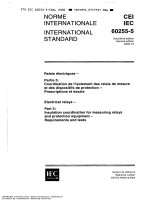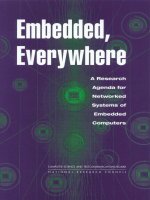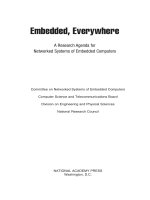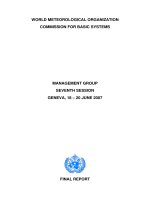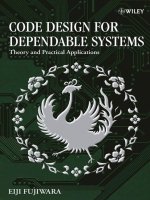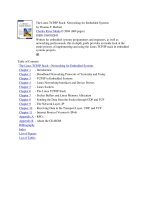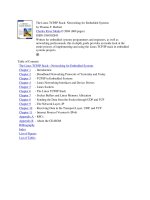TLTK Insulation Coordination for Power Systems
Bạn đang xem bản rút gọn của tài liệu. Xem và tải ngay bản đầy đủ của tài liệu tại đây (9.49 MB, 771 trang )
Insulation Coordination
for
Power Systems
Andrew R. Hileman
Taylor & Francis
Taylor &Francis Group
Boca Raton London New York
A CRC title, part of the Taylor & Francis imprint, a member of the
Taylor & Francis Group, the academic division of T&F Informa pic.
Copyright 1999 by Taylor & Francis Group, LLC
POWER ENGINEERING
Series Editor
H. Lee Willis
ABB Electric Systems Technology Institute
Raleigh, North Carolina
1. Power Distribution Planning Reference Book, H. Lee Willis
2. Transmission Network Protection: Theory and Practice, Y. G. Paithankar
3. Electrical Insulation in Power Systems, N. H. Malik, A. A. A/-Arainy, and M. I.
Qureshi
4. Electrical Power Equipment Maintenance and Testing, Paul Gill
5. Protective Relaying: Principles and Applications, Second Edition, J. Lewis
Blackburn
6. Understanding Electric Utilities and De-Regulation, Lorrin Philipson and H. Lee
Willis
7. Electrical Power Cable Engineering, William A. Thue
8. Electric Power System Dynamics and Stability, James A. Momoh and Mohamed
E. El-Hawary
9. Insulation Coordination for Power Systems, Andrew R. Hileman
ADDITIONAL VOLUMES IN PREPARATION
Copyright 1999 by Taylor & Francis Group, LLC
Published in 1999 by
CRC Press
Taylor & Francis Group
6000 Broken Sound Parkway NW, Suite 300
Boca Raton, FL 33487-2742
0 1999 by Taylor & Francis Group, LLC
CRC Press is an imprint of Taylor & Francis Group
No claim to original U.S. Government works
Printed in the United States of America on acid-free paper
1 0 9 8 7 6 5 4 3
The disks mentioned in this book are now available
for download on the CRC Web site.
International Standard Book Number-10: 0-8247-9957-7 (Hardcover)
International Standard Book Number-13: 978-0-8247-9957-1 (Hardcover)
This book contains information obtained from authentic and highly regarded sources. Reprinted material is quoted with
permission, and sources are indicated. A wide variety of references are listed. Reasonable efforts have been made to publish
reliable data and information, but the author and the publisher cannot assume responsibility for the validity of all materials
or for the consequences of their use.
No part of this book may be reprinted, reproduced, transmitted, or utilized in any form by any electronic, mechanical, or
other means, now known or hereafter invented, including photocopying, microfilming, and recording, or in any information
storage or retrieval system, without written permission from the publishers.
Trademark Notice: Product or corporate names may be trademarks or registered trademarks, and are used only for
identification and explanation without intent to infringe.
Library of Congress Cataloging-in-Publication Data
Catalog record is available from the Library of Congress
Visit the Taylor & Francis Web site at
informa
Taylor & Francis Group
is the Academic Division of T&F Tnforma plc.
Copyright 1999 by Taylor & Francis Group, LLC
and the CRC Press Web site at
The disks mentioned in this book are now available for
download on the CRC Web site.
Power engineering is the oldest and most traditional of the various areas within
electrical engineering, yet no other facet of modern technology is currently undergoing a more dramatic revolution in technology and industry structure.
Deregulation, along with the wholesale and retail competition it fostered, has turned
much of the power industry upside down, creating demands for new engineering
methods and technology at both the system and customer levels.
Insulation coordination, the topic of this latest addition to the Marcel Dekker,
Inc., Power Engineering series, has always been a cornerstone of sound power engineering, since the first interconnected power systems were developed in the early 20th
century. The changes being wrought by deregulation only increase the importance of
insulation coordination to power engineers. Properly coordinated insulation strength
throughout the power system is an absolute requirement for achieving the high levels
of service customers demand in a competitive energy market, while simultaneously
providing the long-term durability and low cost required by electric utilities to meet
their operating and financial goals.
Certainly no one is more the master of this topic than Andrew R. Hileman, who
has long been recognized as the industry's leader in the application of insulation
coordination engineering methods. His Insulation Coordination for Power Systems is
an exceedingly comprehensive and practical reference to the topic's intricacies and an
excellent guide on the best engineering procedures to apply. At both introductory
and advanced levels, this book provides insight into the philosophies and limitations
of insulation coordination methods and shows both a rich understanding of the
structure often hidden by nomenclature and formula and a keen sense of how to
deal with these problems in the real world.
Having had the pleasure of working with Mr. Hileman at Westinghouse for a
number of years in the 1980s, and continuously since then in The Pennsylvania State
Copyright 1999 by Taylor & Francis Group, LLC
vi
Series Introduction
University's power engineering program, it gives me particular pleasure to see his
expertise and knowledge included in this important series of books on power engineering. Like all the books planned for the Power Engineering series, Insulation
Coordinationfor Power Systems presents modern power technology in a context of
proven, practical application. It is useful as a reference book as well as for self-study
and advanced classroom use. The Power Engineering series will eventually include
books covering the entire field of power engineering, in all its specialties and subgenres, all aimed at providing practicing power engineers with the knowledge and
techniques they need to meet the electric industry's challenges in the 21st century.
H. Lee Willis
Copyright 1999 by Taylor & Francis Group, LLC
This book is set up as a teaching text for a course on methods of insulation coordination, although it may also be used as a reference book. The chapter topics are
primarily divided into line and station insulation coordination plus basic chapters
such as those concerning lightning phenomena, insulation strength, and traveling
waves.
The book has been used as a basis for a 3 credit hour, 48 contact hour course.
Each chapter requires a lecture time of from 2 to 6 hours. To supplement the lecture,
problems assigned should be reviewed within the class. On an average, this requires
about 1 to 2 hours per chapter. The problems are teaching problems in that they
supplement the lecture with new material-that is, in most cases they are not considered specifically in the chapters.
The book is based on a course that was originally taught at the Westinghouse
Advanced School for Electric Utility Engineers and at Carnagie-Mellon University
(Pittsburgh, PA). After retirement from Westinghouse in 1989, I extensively revised
and added new materials and new chapters to the notes that I used at Westinghouse.
Thus, this is essentially a new edition. There is no doubt that the training and
experience that I had at Westinghouse are largely responsible for the contents.
The volume is currently being used for a 48 contact hour course in the Advanced
School in Power Engineering at Pennsylvania State University in Monroeville. In
addition, it has been used for courses taught at several U.S. and international utilities. For a one-semester course, some of the chapters must be skipped or omitted.
Preferably, the course should be a two-semester one.
As may be apparent from the preceding discussion, probabilistic and statistical
theory is used extensively in the book. In many cases, engineers either are not
familiar with this subject or have not used it since graduation. Therefore, some
introduction to or review of probability and statistics may be beneficial. At
Copyright 1999 by Taylor & Francis Group, LLC
viii
Preface
Pennsylvania State University, this Insulation Coordination course is preceded by a
48 contact hour course in probability and statistics for power system engineers,
which introduces the student to the stress-strength principle.
The IEEE 1313.2 Standard, Guide for the Application of Insulation
Coordination, is based on the material contained in this book.
I would like to acknowledge the encouragement and support of the
Westinghouse Electric Corporation, Asea Brown Boveri, the Electric Power
Research Institute (Ben Damsky), Duke Energy (Dan Melchior, John Dalton),
and Pennsylvania State University (Ralph Powell, James Bedont). The help from
members of these organizations was essential in production of this book. The education that I received from engineers within the CIGRE and IEEE committees and
working groups has been extremely helpful. My participation in the working groups
of the IEEE Surge Protective Devices Committee, in the Lightning working group of
the IEEE Transmission and Distribution Committee, and in CIGRE working groups
33.01 (Lightning) and 33.06 (Insulation Coordination) has been educational and has
led to close friendships. To all engineers, I heartily recommend membership in these
organizations and encourage participation in the working groups. Also to be
acknowledged is the influence of some of the younger engineers with whom I have
worked, namely, Rainer Vogt, H. W. (Bud) Askins, Kent Jaffa, N. C. (Nick)
AbiSamara, and T. E. (Tom) McDermott. Tom McDermott has been especially
helpful in keeping me somewhat computer-literate.
I have also been tremendously influenced by and have learned from other associates, to whom I owe much. Karl Weck, Gianguido Carrara, and Andy Ericksson
form a group of the most knowledgeable engineers with whom I have been associated. And finally, to my wife, Becky, and my childern, Judy, Linda, and Nancy, my
thanks for "putting up" with me all these years.
Andrew R. Hileman
Copyright 1999 by Taylor & Francis Group, LLC
Series Introduction
Preface
Introduction
H . Lee Willis
Specifying the Insulation Strength
Insulation Strength Characteristics
Phase-Ground Switching Overvoltages, Transmission Lines
Phase-Phase Switching Overvoltages, Transmission Lines
Switching Overvoltages, Substations
The Lightning Flash
Shielding of Transmission Lines
Shielding of Substations
A Review of Traveling Waves
The Backflash
Appendix 1 Effect of Strokes within the Span
Appendix 2 Impulse Resistance of Grand Electrodes
Appendix 3 Estimating the Measured Forming Resistance
Copyright 1999 by Taylor & Francis Group, LLC
Contents
Appendix 4 Effect of Power Frequency Voltage and Number of
Phases
The Incoming Surge and Open Breaker Protection
Metal Oxide Surge Arresters
Appendix 1 Protective Characteristics of Arresters
Station Lightning Insulation Coordination
Appendix 1 Surge Capacitance
Appendix 2 Evaluation of Lightning Surge Voltages Having
Nonstandard Waveshapes: For Self-Restoring Insulations
Line Arresters
Induced Overvoltages
Contamination
National Electric Safety Code
Overview: Line Insulation Design
Appendix
Computer Programs for This Book
Copyright 1999 by Taylor & Francis Group, LLC
1 GOALS
Consider first the definition of insulation coordination in its most fundamental and
simple form:
1. Insulation coordination is the selection of the insulation strength.
If desired, a reliability criterion and something about the stress placed on the insulation could be added to the definition. In this case the definition would become
2. Insulation coordination is the "selection of the insulation strength consistent
with the expected overvoltages to obtain an acceptable risk of failure" [I].
In some cases, engineers prefer to add something concerning surge arresters, and
therefore the definition is expanded to
3. Insulation coordination is the "process of bringing the insulation strengths of
electrical equipment into the proper relationship with expected overvoltages
and with the characteristics of surge protective devices" [2].
The definition could be expanded further to
4.
Insulation coordination is the "selection of the dielectric strength of equipment
in relation to the voltages which can appear on the system for which equipment
is intended and taking into account the service environment and the characteristics of the available protective devices" [3].
5.
"Insulation coordination comprises the selection of the electric strength of
equipment and its application, in relation to the voltages which can appear
Copyright 1999 by Taylor & Francis Group, LLC
Introduction
on the system for which the equipment is intended and taking into account the
characteristics of available protective devices, so as to reduce to an economically and operationally acceptable level the probability that the resulting
voltage stresses imposed on the equipment will cause damage to equipment
insulation or affect continuity of service" [4].
By this time, the definition has become so complex that it cannot be understood by
anyone except engineers who have conducted studies and served on committees
attempting to define the subject and provide application guides. Therefore, it is
preferable to return to the fundamental and simple definition: the selection of insulation strength. It goes without saying that the strength is selected on the basis of some
quantitative or perceived degree of reliability. And in a like manner, the strength
cannot be selected unless the stress placed on the insulation is known. Also, of
course, the engineer should examine methods of reducing the stress, be it through
surge arresters or other means. Therefore, the fundamental definition stands: it is the
selection of insulation strength.
The goal is not only to select the insulation strength but also to select the
minimum insulation strength, or minimum clearance, since minimum strength can
be equated to minimum cost. In its fundamental form, the process should begin with
a selection of the reliability criteria, followed by some type of study to determine the
electrical stress placed on the equipment or on the air clearance. This stress is then
compared to the insulation strength characteristics, from which a strength is selected.
If the insulation strength or the clearance is considered to be excessive, then the stress
can be reduced by use of ameliorating measures such as surge arresters, protective
gaps, shield wires, and closing resistors in the circuit breakers.
As noted, after selection of the reliability criteria, the process is simply a comparison of the stress versus the strength.
Usually, insulation coordination is separated into two major parts:
1. Line insulation coordination, which can be further separated into transmission
and distribution lines
2. Station insulation coordination, which includes generation, transmission, and
distribution substations.
To these two major categories must be added a myriad of other areas such as
insulation coordination of rotating machines, and shunt and series capacitor
banks. Let us examine the two major categories.
2
LINE INSULATION COORDINATION
For line insulation coordination, the task is to specify all dimensions or characteristics of the transmission or distribution line tower that affect the reliability of the
line:
1. The tower strike distances or clearances between the phase conductor and the
grounded tower sides and upper truss
2. The insulator string length
3. The number and type of insulators
4. The need for and type of supplemental tower grounding
5 . The location and number of overhead ground or shield wires
Copyright 1999 by Taylor & Francis Group, LLC
Introduction
xiii
6. The phase-to-ground midspan clearance
7. The phase-phase strike distance or clearance
8. The need for, rating, and location of line surge arresters
To illustrate the various strike distances of a tower, a typical 500-kV tower is shown
in Fig. 1. Considering the center phase, the sag of the phase conductor from the
tower center to the edge of the tower is appreciable. Also the vibration damper is
usually connected to the conductor at the tower's edge. These two factors result in
the minimum strike distance from the damper to the edge of the tower. The strike
distance from the conductor yoke to the upper truss is usually larger. In this design,
the strike distance for the outside phase exceeds that for the center phase. The
insulator string length is about 11.5 feet, about 3% greater than the minimum center
phase strike distance.
Figure 1 Allegheny Power System's 500-kV tower.
Copyright 1999 by Taylor & Francis Group, LLC
Introduction
3
STATION INSULATION COORDINATION
For station insulation coordination, the task is similar in nature. It is to specify
1. The equipment insulation strength, that is, the BIL and BSL of all equipment.
2 . The phase-ground and phase-phase clearances or strike distances. Figure 2
illustrates the various strike distances or clearances that should be considered
in a substation.
3. The need for, the location, the rating, and the number of surge arresters.
4. The need for, the location, the configuration, and the spacing of protective
gaps.
5. The need for, the location, and the type (masts or shield wires) of substation
shielding.
6. The need for, the amount, and the method of achieving an improvement in
lightning performance of the line immediately adjacent to the station.
In these lists, the method of obtaining the specifications has not been stated. To the
person receiving this information, how the engineer decides on these specifications is
not of primary importance, only that these specifications result in the desired degree
of reliability.
It is true that the engineer must consider all sources of stress that may be placed
on the equipment or on the tower. That is, he must consider
1. Lightning overvoltages (LOV), as produced by lightning flashes
2. Switching overvoltages (SOV), as produced by switching breakers or disconnecting switches
Figure 2 The
strike distances and insulation lengths in a substation.
Copyright 1999 by Taylor & Francis Group, LLC
Introduction
xv
3. Temporary overvoltages (TOY), as produced by faults, generator overspeed,
ferroresonance, etc.
4. Normal power frequency voltage in the presence of contamination
For some of the specifications required, only one of these stresses is of importance.
For example, considering the transmission line, lightning will dictate the location
and number of shield wires and the need for and specification of supplemental tower
grounding. Considering the station, lightning will dictate the location of shield wires
or masts. However, subjective judgment must be used to specify whether shield wires
or masts should be used. The arrester rating is dictated by temporary overvoltages.
In addition, the number and location of surge arresters will primarily be dictated by
lightning. Also, for the line and station, the number and type of insulators will be
dictated by the contamination.
However, in many of the specifications, two or more of the overvoltages must be
considered. For transmission lines, for example, switching overvoltages, lightning, or
contamination may dictate the strike distances and insulator string length. In the
substation, however, lightning, switching surges, or contamination may dicatate the
BIL, BSL, and clearances.
Since the primary objective is to specify the minimum insulation strength, no one
of the overvoltages should dominate the design. That is, if a consideration of switching overvoltages results in a specification of tower strike distances, methods should
be sought to decrease the switching overvoltages. In this area, the objective is not to
permit one source of overvoltage stress to dictate design. Carrying this philosophy to
the ultimate results in the objective that the insulation strength be dictated only by
the power frequency voltage. Although this may seem ridiculous, it has essentially
been achieved with regard to transformers, for which the 1-hour power frequency
test is considered by many to be the most severe test on the insulation.
In addition, in most cases, switching surges are important only for voltages of
345 kV and above. That is, for these lower voltages, lightning dictates larger clearances and insulator lengths than do switching overvoltages. As a caution, this may
be untrue for "compact" designs.
4
MODIFICATION OF STRESSES
As previously mentioned, if the insulation strength specification results in a higherthan-desired clearance or insulation strength, stresses produced by lightning and
switching may be decreased. Some obvious methods are the application of surge
arresters and the use of preinsertion resistors in the circuit breakers. In addition,
methods such as the use of overhead or additional shield wires also reduce stress. In
this same vein, other methods are the use of additional tower grounding and additional shielding in the station.
5
TWO METHODS OF INSULATION COORDINATION
Two methods of inuslation coordination are presently in use, the conventional or
deterministic method and the probabilistic method. The conventional method consists of specifying the minimum strength by setting it equal to the maximum stress.
Thus the rule is minimum strength = maximum stress. The probabilistic method
consists of selecting the insulation strength or clearances based on a specific relia-
Copyright 1999 by Taylor & Francis Group, LLC
xvi
Introduction
bility criterion. An engineer may select the insulation strength for a line based on a
lightning flashover rate of 1 flashover/lOO km-years or for a station, based on a mean
time between failure (MTBF), of 100 or 500 years.
The choice of the method is based not only on the engineer's desire but also on
the characteristics of the insulation. For example, the insulation strength of air is
usually described statistically by a Gaussian cumulative distribution, and therefore
this strength distribution may be convolved with the stress distribution to determine
the probability of flashover. However, the insulation strength of a transformer internal insulation is specified by a single value for lightning and a single value for
switching, called the BIL and the BSL. To prove this BIL or BSL, usually only
one application of the test voltage is applied. Thus no statistical distribution of
the strength is available and the conventional method must be used.
It is emphasized that even when the conventional method is used, a probability
of failure or flashover exists. That is, there is a probability attached to the conventional method although it is not evaluated.
The selected reliability criterion is primarily a function of the consequence of the
failure and the life of the equipment. For example, the reliability criterion for a
station may be more stringent than that for a line because a flashover in a station
is of greater consequence. Even within a station, the reliability criterion may change
according to the type of apparatus. For example, because of the consequences of
failure of a transformer, the transformer may be provided with a higher order of
protection. As another example, the design flashover rate for extra high voltage
(EHV) lines is usually lower than that for lower-voltage lines. And the MTBF
criterion for low-voltage stations is lower than for high-voltage stations.
6
REFERENCES
1. IEEE Standard 1313.1-1996, IEEE standard for insulation coordination-definitions,
principles, and rules.
2. ANSI C92.1-1982, American national standard for power systems-insulation coordination.
3. IEC 71-1-1993-12, Insulation coordination Part 1: Definitions, principles and rules.
4. IEC Publication 71-1-1976, Insulation coordination, Part 1: Terms, definitions and rules.
Copyright 1999 by Taylor & Francis Group, LLC
Specifying the
Insulation Strength
As discussed in the introduction, insulation coordination is the selection of the
strength of the insulation. Therefore to specify the insulation strength, the usual,
normal, and standard conditions that are used must be known. There also exist
several methods of describing the strength, such as the BIL, BSL, and CFO,
which must be defined. It is the purpose of this chapter to describe the alternate
methods of describing the strength and to present the alternate test methods used to
determine the strength. In addition, a brief section concerning generation of impulses
in a laboratory is included.
1
STANDARD ATMOSPHERIC CONDITIONS
All specifications of strength are based on the following atmospheric conditions:
1.
2.
3.
4.
Ambient temperature: 20°
Air pressure: 101.3kPa or 760mm Hg
Absolute humidity: 11 grams of water/m3 of air
For wet tests: 1 to 1.5mm of waterlminute
If actual atmospheric conditions differ from these values, the strength in terms of
voltage is corrected to these standard values. Methods employed to correct these
voltages will be discussed later.
2
TYPES OF INSULATION
Insulation may be classified as internal or external and also as self-restoring and nonself-restoring. Per ANSI C92.l (IEEE 1313.1) [1,2].
Copyright 1999 by Taylor & Francis Group, LLC
Chapter 1
2.1
External Insulation
External insulation is the distances in open air or across the surfaces of solid insulation in contact with open air that are subjected to dielectric stress and to the effects
of the atmosphere. Examples of external insulation are the porcelain shell of a
bushing, bus support insulators, and disconnecting switches.
2.2
Internal Insulation
Internal insulation is the internal solid, liquid, or gaseous parts of the insulation of
equipment that are protected by the equipment enclosures from the effects of the
atmosphere. Examples are transformer insulation and the internal insulation of
bushings. Equipment may be a combination of internal and external insulation.
Examples are a bushing and a circuit breaker.
2.3
Self-Restoring (SR) Insulation
Insulation that completely recovers insulating properties after a disruptive discharge
(flashover) caused by the application of a voltage is called self-restoring insulation.
This type of insulation is generally external insulation.
2.4
Non-Self-Restoring (NSR) Insulation
This is the opposite of self-restoring insulators, insulation that loses insulating properties or does not recover completely after a disruptive discharge caused by the
application of a voltage. This type of insulation is generally internal insulation.
3
3.1
DEFINITIONS OF APPARATUS STRENGTH, THE BIL AND THE
BSL
BIL-Basic
Lightning Impulse Insulation Level
The BIL or basic lightning impulse insulation level is the electrical strength of
insulation expressed in terms of the crest value of the "standard lightning impulse."
That is, the BIL is tied to a specific waveshape in addition being tied to standard
atmospheric conditions. The BIL may be either a statistical BIL or a conventional
BIL. The statistical BIL is applicable only to self-restoring insulations, whereas the
conventional BIL is applicable to non-self-restoring insulations. BILs are universally
for dry conditions.
The statistical BIL is the crest value of standard lightning impulse for which the
insulation exhibits a 90% probability of withstand, a 10% probability of failure.
The conventional B I L is the crest value of a standard lightning impulse for which
the insulation does not exhibit disruptive discharge when subjected to a specific
number of applications of this impulse.
In IEC Publication 71 [3], the BIL is known as the lightning impulse withstand
voltage. That is, it is defined the same but known by a different name. However, in
IEC, it is not divided into conventional and statistical definitions.
Copyright 1999 by Taylor & Francis Group, LLC
Specifying the Insulation Strength
3.2 BSL-Basic
Switching Impulse Insulation Level
The BSL is the electrical strength of insulation expressed in terms of the crest value
of a standard switching impulse. The BSL may be either a statistical BSL or a
conventional BSL. As with the BIL, the statistical BSL is applicable only to selfrestoring insulations while the conventional BSL is applicable to non-self-restoring
insulations BSLs are universally for wet conditions.
The statistical B S L is the crest value of a standard switching impulse for which
the insulation exhibits a 90% probability of withstand, a 10% probability of failure.
The conventional B S L is the crest value of a standard switching impulse for
which the insulation does not exhibit disruptive discharge when subjected to a
specific number of applications of this impulse.
In IEC Publication 71 [3], the BSL is called the switching impulse withstand
voltage and the definition is the same. However, as with the lightning impulse withstand voltage, it is not segregated into conventional and statistical.
3.3
Standard Waveshapes
As noted, the BIL and BSL are specified for the standard lightning impulse and the
standard switching impulse, respectively. This is better stated as the standard lightning or switching impulse waveshapes. The general lightning and switching impulse
waveshapes are illustrated in Figs. 1 and 2 and are described by their time to crest
and their time to half value of the tail. Unfortunately, the definition of the time to
crest differs between these two standard waveshapes. For the lightning impulse
waveshape the time to crest is determined by first constructing a line between two
points: the points at which the voltage is equal to 30% and 90% of its crest value.
The point at which this line intersects the origin or zero voltage is called the virtual
origin and all times are measured from this point. Next, a horizontal line is drawn at
the crest value so as to intersect the other line drawn through the 30% and 90%
points. The time from the virtual origin to this intersection point is denoted as the
time to crest or as the virtual time to crest t f .The time to half value is simply the time
between the virtual origin and the point at which the voltage decreases to 50% of the
crest value, tT. In general, the waveshape is denoted as a t d t T impulse. For example
/
VOLTAGE
LIGHTNING IMPULSE
Figure 1
Lightning impulse wave shape.
Copyright 1999 by Taylor & Francis Group, LLC
Chapter 1
VOLTAGE
SWITCHING IMPULSE
Figure 2
Switching impulse wave shape.
with a 1000-kV, 2.0/100-ps impulse, where the crest voltage is 1000kV, the virtual
time to crest or simply the time to crest is 2 ps and the time to half value is 100 ps. In
the jargon of the industry, t f is more simply called the front, and tT is called the tail.
The front can better be defined by the equation
where tag is the actual time to 90% of the crest voltage and tw is the actual time to
30% of crest voltage.
The standard lightning impulse waveshape is 1.2150 ps. There exists little doubt
that in the actual system, this waveshape never has appeared across a piece of
insulation. For example, the actual voltage at a transformer has an oscillatory waveshape. Therefore it is proper to ask why the 1.2150 ps shape was selected. It is true
that, in general, lightning surges do have short fronts and relative short tails, so that
the times of the standard waveshape reflect this observation. But of importance in
the standardization process is that all laboratories can with ease produce this waveshape.
Although the tail of the switching impulse waveshape is defined as the time to
half value, the time is measured from the actual time zero and not the virtual time
zero. The time to crest or front is measured from the actual time zero to the actual
crest of the impulse. The waveshape is denoted in the same manner as for the lightning impulse. For example, a lOOOkV, 200/3000ps switching impulse has a crest
voltage of 1000kV, a front of 200 ps, and a tail of 3000 ps. The standard switching
impulse waveshape is 25012500 ps. For convenience, the standard lightning and
switching impulse waveshapes and their tolerances are listed in Table 1.
3.4
Statistical vs. Conventional BILIBSL
As noted, the statistical BIL or BSL is defined statistically or probabilistically. For
every application of an impulse having the standard waveshape and whose crest is
equal to the BIL or BSL, the probability of a flashover or failure is 10%. In general,
the insulation strength characteristic may be represented by a cumulative Gaussian
distribution as portrayed in Fig. 3. The mean of this distribution or characteristic is
Copyright 1999 by Taylor & Francis Group, LLC
Specifying the Insulation Strength
Table 1
Standard Impulse Wave Shapes and Tolerances
Impulse Type +
Nominal Wave Shape
Lightning
1.2150 pS
Switching
250/2500 ps
Tolerances
front
tail
Source: Ref. 4.
defined as the critical flashover voltage or CFO. Applying the CFO to the insulation
results in a 50% probability of flashover, i.e., half the impulses flashover. Locating
the BIL or BSL at the 10% point results in the definition that the BIL or BSL is 1.28
standard deviations, of,below the CFO. In equation form
Sigma in per unit of the CFO is properly called the coefficient of variation.
However, in jargon, it is simply referred to as sigma. Thus a sigma of 5% is interpreted as a standard deviation of 5% of the CFO. The standard deviations for
lightning and switching impulses differ. For lightning, the standard deviation or
sigma is 2 to 3%, whereas for switching impulse, sigma ranges from about 5% for
tower insulation to about 7% for station type insulations, more later.
The conventional BIL or BSL is more simply defined but has less meaning as
regards insulation strength. One or more impulses having the standard waveshape
and having a crest value equal to the BIL or BSL are applied to the insulations. If no
flashovers occur, the insulation is stated to possess a BIL or BSL. Thus the insulation
strength characteristic as portrayed in Fig. 4 must be assumed to rise from zero
probability of flashover or failure at a voltage equal to the BIL or BSL to 100%
probability of flashover at this same BIL or BSL.
CFO
kV
or
BIL
Figure 3
Insulation strength characteristic for self-restoring insulation.
Copyright 1999 by Taylor & Francis Group, LLC
Chapter 1
or
BSL
Figure 4
3.5
Insulation strength characteristic for non-self-restoring insulation.
Tests to "Prove" the BIL and BSL
Tests to establish the BIL or BSL must be divided between the conventional and the
statistical. Since the conventional BIL or BSL is tied to non-self-restoring insulation,
it is more than highly desirable that the test be nondestructive. Therefore the test is
simply to apply one or more impulses having a standard impulse waveshape whose
crest is equal to the BIL or BSL. If no failure occurs, the test is passed. While it is
true that some failures on the test floor do occur, the failure rate is extremely low.
That is, a manufacturer cannot afford to have failure rates, for example on power
transformers, that exceed about 1%. If this occurs, production is stopped and all
designs are reviewed.
Considering the establishment of a statistical BIL or BSL, theoretically no test
can conclusively prove that the insulation has a 10% probability of failure. Also
since the insulation is self-restoring, flashovers of the insulation are permissible.
Several types of tests are possible to establish an estimate of the BIL and BSL.
Theoretically the entire strength characteristic could be determined as illustrated
in Fig. 3, from which the BIL or BSL could be obtained. However, these tests are
not made except perhaps in the equipment design stage. Rather, for standardization,
two types of tests exist, which are
1. The n/m test: m impulses are applied. The test is passed if no more than n
result in flashover. The preferred test presently in IEC standards is the 2/15 test. That
is, 15 impulses having the standard shapes and whose crest voltage is equal to the
BIL or BSL are applied to the equipment. If two or fewer impulses result in flashover, the test is passed, and the equipment is said to have the designated BIL or BSL.
2. The n + m test: n impulses are applied. If none result in flashover, the test is
passed. If there are two or more flashovers, the test is failed. If only one flashover
occurs, m additional impulses are applied and the test is passed if none of these
results in a flashover. The present test on circuit-breakers is the 3 + 3 test [5]. In IEC
standards, an alternate but less preferred test to the 2/15 test is the 3 + 9 test [6].
These alternate tests can be analyzed statistically to determine their characteristic.
That is, a plot is constructed of the probability of passing the test as a function of the
Copyright 1999 by Taylor & Francis Group, LLC
7
Specifying the Insulation Strength
actual but unknown probability of flashover per application of a single impulse. The
characteristics for the above three tests are shown in Fig. 5. These should be compared to the ideal characteristic as shown by the dotted line. Ideally, if the actual
probability of flashover is less than 0.10, the test is passed, and ideally if the probability is greater than 0.10 the test is failed. The equations for these curves, where P is
the probability of passing, p is the probability of flashover on application of a single
impulse, and q is ( 1 - p ) , are
For the 2/15 test
+ 3 test
For the 3 + 9 test
For the 3
P = q15 + 15pq14 + 105p2q13
+ 3pq5
P = q3 + 9pq1'
3
P =q
(3)
Per Fig. 5, if the actual (but unknown) probability of flashover for a single impulse is
0.20, then even though this probability of flashover is twice that defined for the BIL
or BSL, the probabilities of passing the tests are 0.71 for the 3 3,0.56 for the 3 9,
and 0.40 for a 2/15. That is, even for an unacceptable piece of equipment, there exists
a probability of passing the test. In a similar manner there exists a probability of
failing the test even though the equipment is "good." For example, if the probability
of flashover on a single impulse of 0.05, the probability of failing the test is 0.027 for
the 3 3 test, 0.057 for the 3 + 9 test, and 0.036 for the 2/15 test. In general then, as
illustrated in Fig. 6, there is a manufacturer's risk of having acceptable equipment
and not passing the test and a user's risk of having unacceptable equipment and
passing the test. A desired characteristic is that of discrimination, discriminating
between "good" and "bad." The best test would have a steep slope around the
0.10 probability of flashover. As is visually apparent, the 2/15 is the best of the
three and the 3 3 is the worst. Therefore it is little wonder that the IEC preferred
test is the 2/15. The 3 9 test is a compromise between the 3 3 and the 2/15 tests
included in the IEC Standard at the request of the ANSI circuit breaker group. The
unstated agreement is that ANSI will change to the 3 9 test.
+
+
+
+
+
+
0.0
0.1
0.2
0.3
0.4
0.5
p=probability of flashover per impulse
Figure 5
Characteristics for alternate test series.
Copyright 1999 by Taylor & Francis Group, LLC
+
Chapter 1
Manufacturer's Risk
0.0
0.1
0.2
0.3
0.4
0.5
p-robability of flashover per impulse
Figure 6
3.6
Manufacturer's and user's risk.
Standard BILs and BSLs
There exists a standard number series for both BILs and BSLs that equipment
standards are encouraged to use. In the USA, ANSI C92 and IEEE 1313.1 lists
the values shown in Table 2, while IEC values are shown in Table 3.
These values are "suggested" values for use by other equipment standards. In
other words, equipment standards may use these values or any others that they deem
necessary. However, in general, these values are used. There are exceptions. For any
specific type of equipment or type of insulation, there does exist a connection
between the BIL and the BSL. For example, for transformers, the BSL is approximately 83% of the BIL. Thus given a standard value of the BIL, the BSL may not be
a value given in the tables. In addition, in IEC, phase-phase tests are specified to
verify the phase-phase BSL. The phase-phase BSL is standardized as from 1.5 to 1.7
times the phase-ground BSL. Thus, in this case, the BSL values are not the values
listed.
Standard Values of BIL and BSL per ANSI C92,
IEEE 1313.1
Table 2
Source: Ref. 7.
Copyright 1999 by Taylor & Francis Group, LLC
Specifying the Insulation Strength
Table 3
Standard Values of BIL and BSL per IEC 71.1
Source: Ref. 5
In the ANSI Insulation Coordination Standard, C92, no required values are
given for alternate system voltages. That is, the user is free to select the BIL and
BSL desired. However, practically, there are only a limited number of BILs and
BSLs used at each system voltage. For the USA, these values are presented in
Tables 4 and 5 for transformers, circuit breakers7 and disconnecting switches. For
Class I power transformers, the available BILs are 45, 60, 75, 95, 110, 150, 200, 250
and 350 kV. For distribution transformers, the available BILs are 30, 45, 60, 75, 95,
125, 150, 200, 250 and 350 kV.
BSLs are not given in ANSI standards for disconnecting switches. The values
given in the last column of Table 5 are estimates of the BSL. Note also that BSLs for
circuit breakers are only given for system voltages of 345 kV or greater. This is based
on the general thought that switching overvoltages are only important for these
system voltages. Also7 for breakers, for each system voltage two BSL ratings are
given, one for the breaker in the closed position and one when the breaker is opened.
For example, for a 550-kV system, the BSL of the circuit breaker in the closed
position is 1175kV, while in the opened position the BSL increases to 1300kV.
BILsIBSLs of gas insulated stations are presented in Table 6, and BILs of cables
are shown in Table 7. In IEC, BILs and BSLs are specified for each system voltage.
These values are presented in Tables 8 and 9, where BSLg is the phase-ground BSL,
and BSLp is the phase-phase BSL. Note as in ANSI, BSLs are only specified for
maximum system voltages at and above 300 kV. Phase-phase BSLs are not standardized in the USA.
3.7
CFO and ~r~ICFO-~~Probability
Run Tests"
An alternate method of specifying the insulation strength is by providing the parameters of the insulation strength characteristic, the CFO and of/CFO. This method
is only used for self-restoring insulations since flashovers are permitted: they do
occur. This method of describing the insulation strength characteristic is primarily
used for switching impulses. However, the method is equally valid for lightning
impulses although only limited data exist. For example, the switching impulse insulation strength of towers, bus support insulators, and gaps are generally specified in
this manner.
Copyright 1999 by Taylor & Francis Group, LLC
